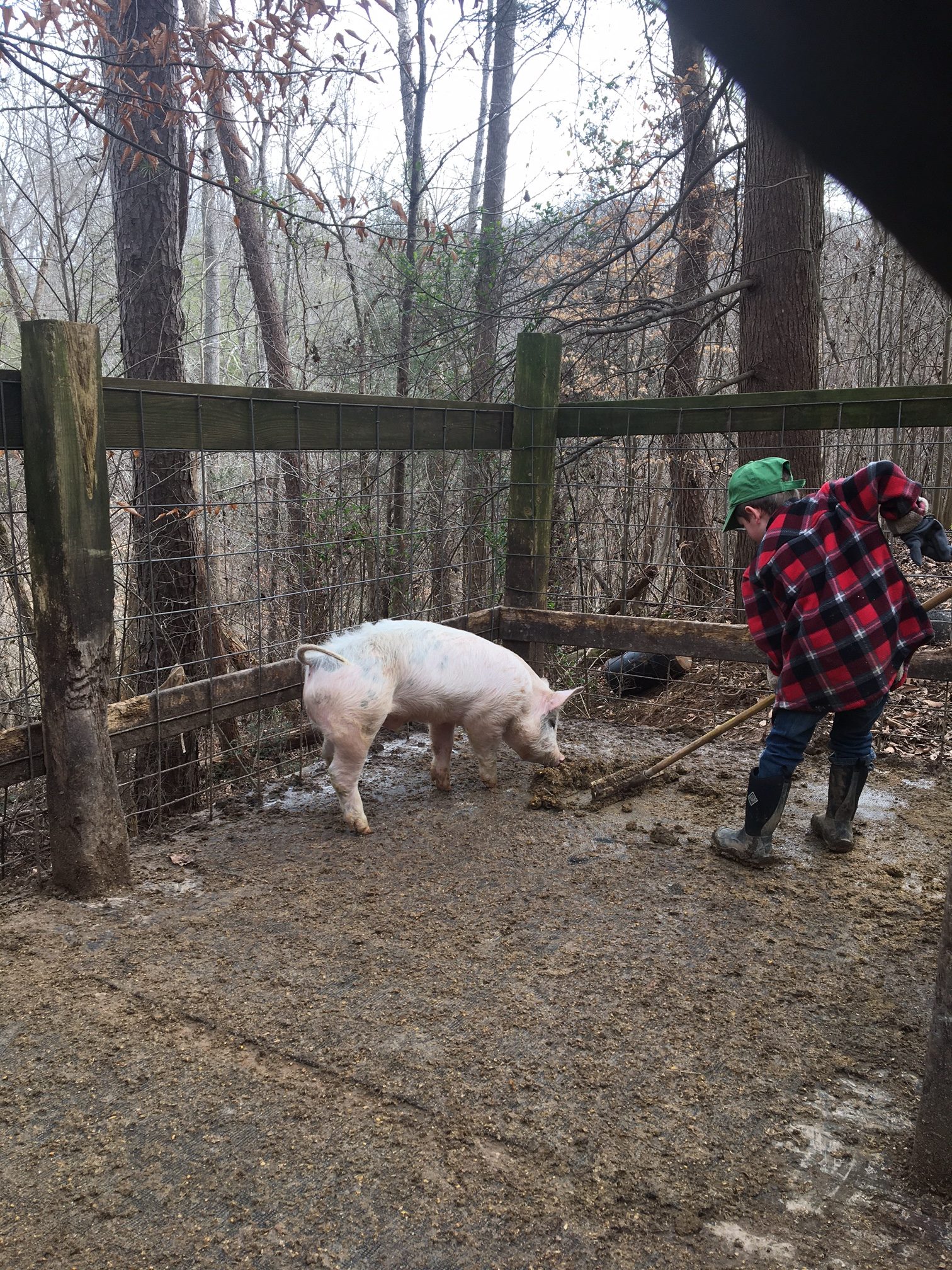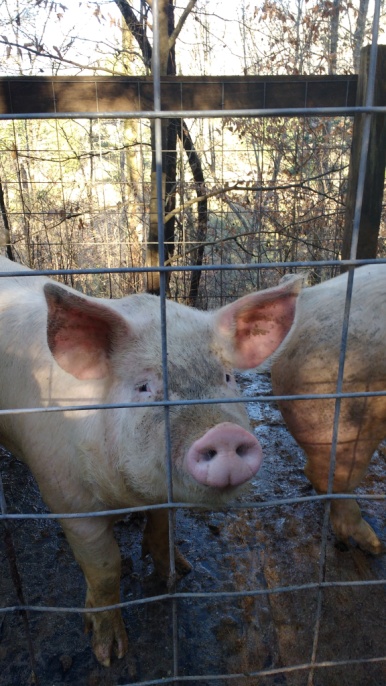Processing Pork: Why Do We Butcher Our Own Hogs?

Why in the world would we take two whole days out of our lives to process our own pork? Aren’t there places out there where someone else can butcher your hog?
Our Purpose Behind Processing Pork Ourselves
We are passionate about doing things at home. My husband and I love to process our own meat, grow our own garden, and do whatever we can by ourselves at our own farm because we just want to! It’s free, it’s fun, and it’s so rewarding!
Some of you might be thinking, how in the world can this be so fun? It’s a ton of hard work. It’s messy. It involves killing an animal… But when you are finished, you have a freezer full of delicious meat for all your efforts. Big win for me!
Ever Heard of the Foxfire Books?
I did some research this year before butchering our hog. We have done our own pork two or three times together, but this year I really got into it. I love the Foxfire series that was written back in 1968! I have the 1972 edition of The Foxfire Book. I am obsessed with these books! They are full of information and how-to’s about traditional Appalachian life. This is my go-to resource for all my “Old Timey” projects. Foxfire had three chapters dedicated to hog slaughtering, so this has been my guide for the past weeks as I made notes and lists, and looked forward to Hog Day. (You may find as you read my posts, I am a bit obsessive, so when I do something I go all out.)
It was our goal this year to use all the meat we possibly could. I knew it would be a lot of extra work. But I wanted a real taste of how “old people” butchered and processed their pork.

Butchering the Hog was A Family Affair
Many of you reading this may remember your parents or your grandparents killing their hog every year. It was a very normal, reliable, part of life in this area up until probably fifty years ago. Some families still keep the tradition. Thankfully, we have refrigerators and freezers. This is so helpful. I can’t imagine living without our appliances. But somehow, our ancestors did and they lived to tell about it.
My grandpa Don Abbott and his family killed their hog every year around Thanksgiving. It was an extended family affair, too.
“We would kill our hog, and Uncle Ed would be there. Us kids would blow up the bladder to play ball with. They’d blow it up with a cane stick and we’d use it like a volleyball.”
I wanted to especially make some traditional Appalachian recipes with pieces of the hog we would usually toss. Recipes many of you will remember your mother making. Some of you loved it. Some of you never want to see souse meat or liver pudding again! I’ve found some people are interested in processing meat by hand, but others don’t care a bit and thank God for the grocery store.
We Know Where Our Food Comes From
Another reason besides wanting to do things the old-fashioned way, is that I know where my meat comes from, and I know it is clean!

This reason is a bit more important than nostalgia. My husband is the butcher and I make sure everything is clean. I don’t want to knock our local butcher, because they are great, but I can about bet my kitchen is cleaner than a slaughterhouse. At least it smells better when you walk in the door!
We Can Guarantee Cleanliness
After the hog is…expired…the butchering process is done quickly, all in the same day. It is clean and the temperature is just right, guaranteeing no bacterial growth. You want slaughtering day to be below 38 degrees. It’s a cold job! My husband took off work for the occasion.
The sections of meat are then put into clean containers. It’s transferred through only my husband’s hands, and never allowed to touch the floor or anything nasty.

He will quarter the hog up outdoors, because he needs A LOT of space. He’s got the hose going over the meat when he needs to rinse it, so any specks of yucky will be gone. After all the big parts are butchered, he stores them in clean coolers or the fridge.
The meat is then brought into the house for the fine touches and specific cuts of meat. We use a clean sink, counters, and table to get the rest of the processing done. We immediately vacuum seal the meat with our amazing Food Saver vacuum sealer, and put it right into the freezer!
We’ve streamlined the process over the years, so we have it down pretty good. It still takes two days, but we are constantly working and getting meat put up.
Hard Doesn’t Mean Bad
I love that I can say I know exactly where my meat comes from. I know for sure it’s been handled properly and safely. I feel great about feeding my family healthy and clean food!
These benefits are definitely worth all the hard work that my husband puts into this hog. He has fed it, cared for it, and then finally uses it for its purpose. (Sorry to those who have watched Babe…we love that movie too, but I be sure and tell the kids that we wouldn’t have bacon without the sacrifice of a pig.)
That’s another thing. I want my children to know where their food comes from. I want to pass on traditional skills to my boys. It’s becoming very rare for children to know anything about where their meat comes from. My boys love to take care of our animals. But when it comes time for slaughter, they understand that we only kill for meat. Everything on a farm has a purpose. The circle of life…and all that.
We didn’t want to waste much this time around. We planned to use almost everything. We did NOT use the brains, ears, eyes, skin, snout, tail, feet, stomach, intestines, or lungs. But we used almost everything else on the old boy! My husband figured we had about 10 lbs worth of stuff we threw out. (This is just trimmings from meat, not counting the skin or innards.) Considering a 400 lb hog, I’d say we did well.
Slaughtering the family hog has been done for generations. In the photos in the following posts, you’ll see Papaw Fred helping my husband with the process. He has been a huge help through the years when it comes to old time things. He remembers his parents doing all of it. They grew up in Ballplay, TN. If he has a question, he’ll call his older sister, sweet Una Lee, and she’ll be sure to remember! My favorite saying from Papaw Fred is, “We used everything but the squeal.” Thanks to him for all the help and input on the recipes! (He’s a great taste-tester.)
I’m so excited to be able to share our experience and process with ya’ll! I’ve been brainstorming and researching so I can write about it. Please share your memories and experiences, too! And I’d love to know if anyone still likes Liver Pudding or Souse Meat!
Next in this series:
Processing Pork Part Two: Preparing the Hog
Processing Pork Part Three: Butchering, Packaging, and Storing
See more posts about our homestead in Farm Life


